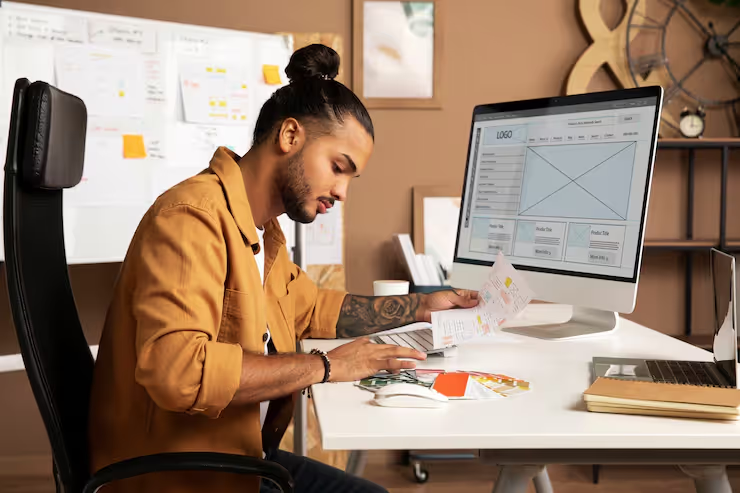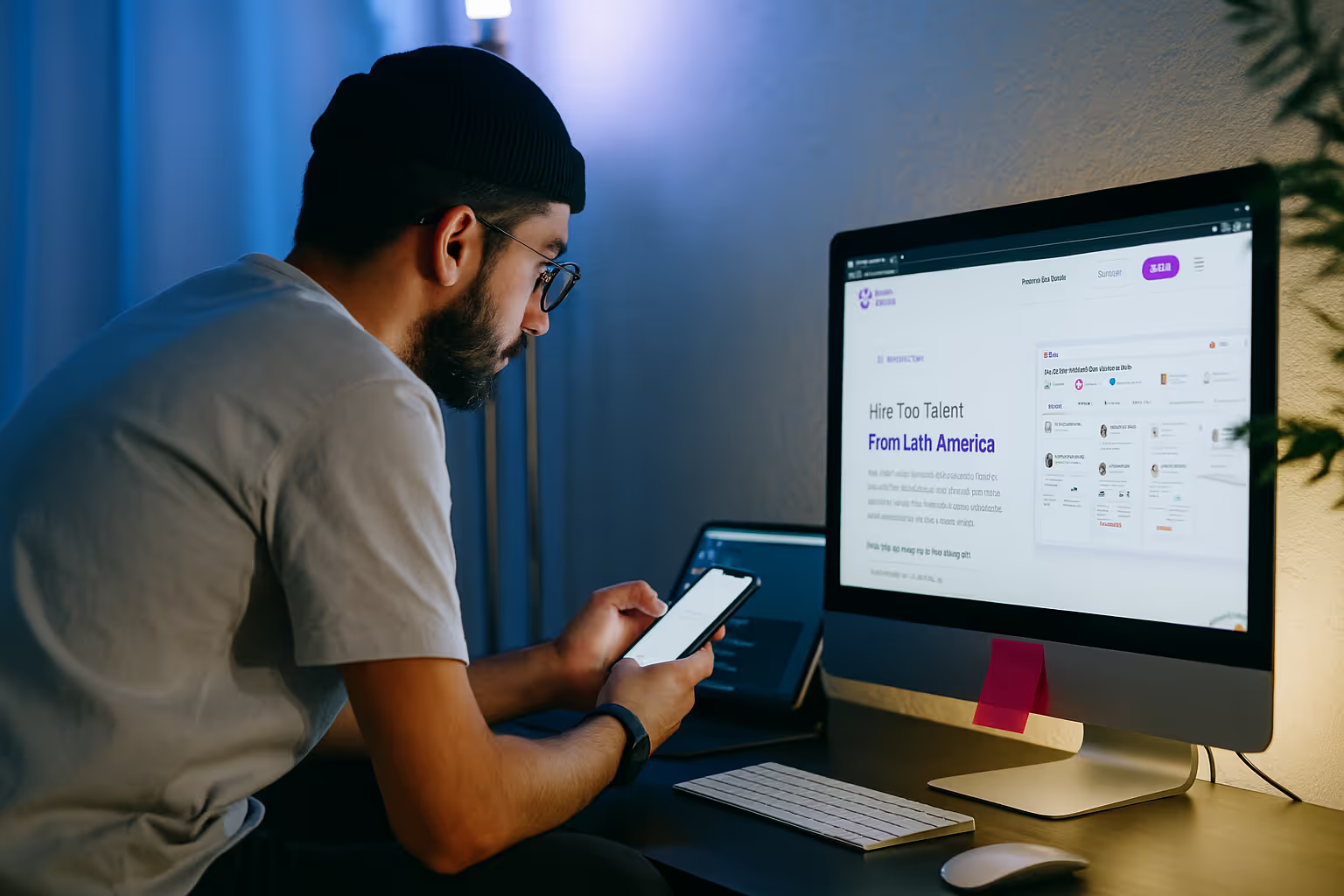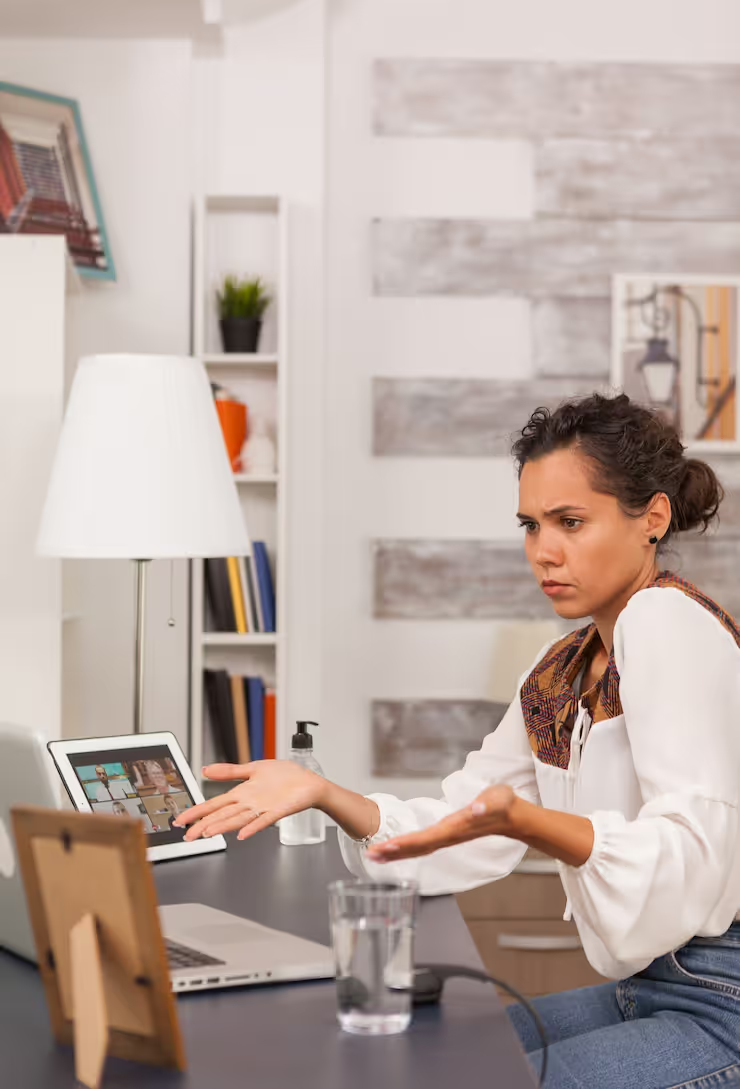How to Find a Web Designer Remote Job

Table Content:
Where to Find a Web Designer Remote Job
So, How to Find a Web Designer Remote Job?
Web designer job description and salary (For Latam)
How to Build a Portfolio That Gets You Hired?
Conclusion

So, you’re thinking about finding a web designer remote job? That's great!! Nowadays, more and more companies around the world are hiring remotely, and that means you can land a web designer remote job without relocating. Whether you’re based in Colombia, Argentina, Venezuela, or Uruguay, there are real opportunities to work with global brands and agencies, from your casita.
In fact, there’s a growing demand for skilled designers from Latam in international markets. You’ll find web designer jobs remote UK, remote web designer jobs in USA, and web designer jobs Canada remote that are open to remote top talent worldwide. And many of them are hiring junior and mid-level designers, not just senior pros.
You don’t need a degree or decades of experience to break in. There are tons of remote entry level web design jobs, junior web designer remote jobs, and even part-time remote web designer jobs for beginners who know how to showcase their skills.
Here we want you to learn:
- The real web design job roles out there (designer vs developer).
- Build a standout portfolio that makes you irresistible to remote employers.
- Review the best platforms for freelance web designer jobs (remote of course) or land a full-time job.
Whether you're starting from cero, upskilling to go remote, or ready to leave office life for good, this roadmap to land a web design job remotely, and build the career (and lifestyle) you've been looking for.
Where to Find a Web Designer Remote Job
Sometimes it could be frustrating looking for companies hiring and not finding anything, especially from Latin America; finding the right web designer remote job can feel overwhelming. And for another side, There could be hundreds of job boards, scattered freelance listings, and countless companies posting opportunities in different time zones. But here’s the truth: once you know where to look (and what to look for), finding the right fit becomes way easier.

Let’s break down three of the best places to find a remote web design job that are open to international candidates, including freelance gigs, junior roles, and long-term opportunities with companies based in Canada and USA.
Remote Latinos App
Remote Latinos App, Best for part-time or full-time jobs, it has filtered jobs with a strong design category, all companies are open to Latin American applicants and it also has a partnership program with Deel so members can receive salary directly from employers without third-parties intermediary and lower commissions.

Best for Remote roles across all levels. Use filters like “remote,” “junior,” and even target web designer jobs remote UK or Canada remote. Don’t forget to set alerts!
Torre.ai
It offers Remote-Friendly Opportunities, specialized in remote job listings, making it a valuable resource for Latin American professionals aiming to work with international companies. While Torre AI offers various job listings, some users have noted that certain specialized roles may not be as prominently featured, potentially requiring additional job search strategies.
So, How to Find a Web Designer Remote Job?
Easy, fast and summarized. Here's how to get started:
1. Understand the Role
Know what’s expected: design layouts, responsive pages, and basic UX. Check listings to understand the difference between design and development roles.
2. Build the Right Skills
Learn tools like Figma or Webflow, plus HTML/CSS basics. WordPress knowledge is a bonus for many roles.
3. Create a Strong Portfolio
Show 3–5 polished projects. Highlight your design process, results, and mobile responsiveness. Testimonials are a big plus.
4. Set Up a Personal Website
Keep it clean and on-brand. Include your portfolio, contact info, and a short bio. A strong site builds trust with international clients.
5. Apply Smart
Use trusted platforms like Remote Latinos App, We Work Remotely, and LinkedIn. Search by role and region: "web designer jobs remote UK", "WordPress designer remote", etc.
6. Keep Improving
Refine your skills, update your portfolio, and stay visible. Remote design is competitive, consistency matters.

Web designer job description and salary (For Latam)
Before continuing reading, this salary range is for Latam remote candidates. So, applying to any web designer remote job, it’s important to understand what companies are actually looking for, and how much you can realistically earn if you live in Venezuela, Colombia, Argentina, Uruguay or any other Latam country. Knowing the typical web designer job description and salary helps you better position your skills, set your rates, and avoid being underpaid, especially in international markets.
Web designer job description
While every company has different expectations, most remote web design jobs include the following core responsibilities:
- Designing visually appealing and user-friendly layouts for websites or apps.
- Creating wireframes, mockups, and prototypes (using tools like Figma, Adobe XD, or Sketch)
- Creating responsive design across mobile, tablet, and desktop.
- Collaborating with developers and content teams (often asynchronously).
- Updating or redesigning existing websites for better UX and performance and SEO.
If you’re applying for freelance web designer jobs remote, clients may also expect you to:
- Communicate directly with them about goals, changes, updates or revisions.
- Handle your own time management and deadlines.
- Manage invoicing or contracts.
- Have an B2/C1 english level.
Web designer remote job salary
Salaries can vary a lot based on experience, skill set, country of the hiring company, and whether you're working full-time or freelance. Here’s a general range to help set your expectations for web design jobs in remote positions for Latam:
- Junior Web Designer: $400 – $500
- Senior Web Designer: $600 – $1200
- Freelancers: $5 – $15 hour (or more)

How to Build a Portfolio That Gets You Hired?
When you’re applying to remote web design jobs, your portfolio is your first interview. Employers and clients abroad don’t know you yet, so your work needs to speak for you.
Think of your portfolio as your digital handshake. It should instantly show that you're capable, creative, reliable, and ready to work across time zones. Whether you’re going for junior web designer remote jobs, senior role or pitching for a freelance gig, a polished portfolio is your #1 selling tool.
So, your portfolio must demonstrate:
- That you understand design principles like layout, contrast, and usability.
- That you can follow a brief, solve design problems, and deliver polished work (Attention to details).
- That you take your craft seriously, and that you’re not just “trying it out”.
Showing your creative process, not just the final product, helps clients and employers see how you think and problem-solve.
Showcase 3 to 5 Strong Projects
You don’t need a huge gallery. In fact, most recruiters prefer quality over quantity. Three to five excellent case studies is the sweet spot, especially for remote entry level web design jobs or junior roles.
Each project should demonstrate a different skill or specialty, such as:
- A homepage redesign showing your visual hierarchy and layout skills.
- A mobile-responsive ecommerce site.
- A client blog built with WordPress (great for WordPress website designer remote jobs).
- A landing page with UX thinking and conversion focus.
Include Process Breakdowns, Client Testimonials (If Any), and Responsive Designs
Let’s be honest: anyone can post pretty screenshots. What sets you apart is showing how you got there.
Use each portfolio item to:
- Explain your goals, challenges, and design choices
- Walk through your process from idea to wireframe to final result.
- Add a testimonial if it was a real project, even one line from a happy client or mentor goes a long way.
- Show works on mobile, tablet, and desktop, responsive design is non-negotiable for most web designer jobs remote.
Tip: Use Loom to record a 1–2 minute video walkthrough of your best project. It adds personality and builds trust.
Consider a Personal Website That Reflects Your Branding
Hosting your portfolio on a well-designed personal website shows initiative and professionalism, especially to employers in Canada or USA.
Your site doesn’t need to be complex. A clean one-page site built with Webflow, Framer, or WordPress can be enough.
Make sure it includes:
- A short bio + clear photo.
- Link to your resume.
- Contact info (email, Calendly, or even WhatsApp).
- Social links (LinkedIn, Dribbble, Behance).
- Clean layout, fast loading, and responsive design.
“A client doesn’t hire your tools, they hire your brain. Your website should reflect how you think, work, and communicate.”
Conclusion
Finding a web designer remote job might feel like a big leap, especially if you're applying from Latin America to companies in Canada or USA. But here’s the truth: your location doesn’t define your potential.
With the right skills, a clear portfolio, and a smart job search strategy, you can absolutely land amazing remote web design jobs, even without years of experience or a big-name agency on your resume.
Now it’s your turn!! Pick one job at Remote Latinos App and start today. Your dream job won’t just land in your inbox, but it will come if you’re consistent, clear, and confident.
Sources:
Chevalier, A., & Ivory, M. Y. (2003). Web site designs: Influences of designer’s expertise and design constraints. International Journal of Human-Computer Studies, 58(1), 57–87. https://doi.org/10.1016/S1071-5819(02)00126-X
DiFeterici, G. (2012). The Web Designer’s Roadmap: Your Creative Process for Web Design Success. SitePoint Pty. Ltd.
McNeil, P. (2010). The Web Designer’s Idea Book, Vol. 2: More of the Best Themes, Trends and Styles in Website Design. HOW Books.
Monteiro, M., Kleon, A., & Robert, C. (2015). Web designer cherche client idéal [You’re My Favorite Client] (French ed.). Éditions Eyrolles.
Wyke-Smith, C. (2007). Codin’ for the Web: A Designer’s Guide to Developing Dynamic Web Sites. New Riders.
Womack, J. (2008). Becoming a Digital Designer: A Guide to Careers in Web, Video, Broadcast, Game, and Animation Design. John Wiley & Sons.

.png)
.png)
.png)

